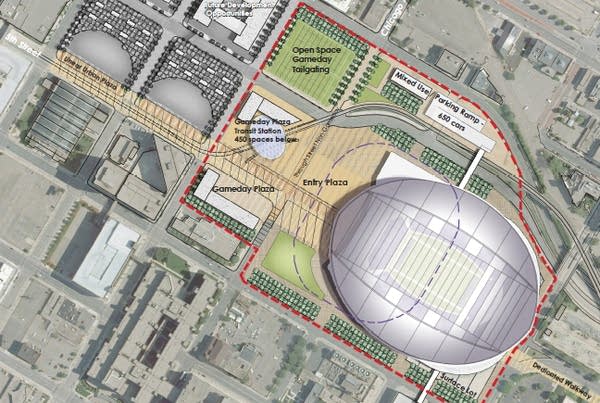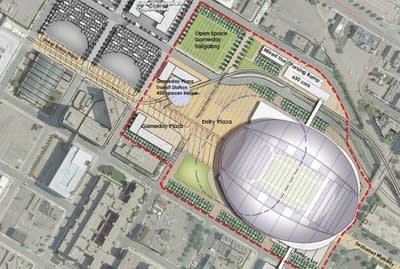Vikings stadium plan in place, but deal isn't sealed yet

Gov. Mark Dayton and the owners of the Minnesota Vikings said Thursday they've got a preliminary agreement to build the team a new stadium in Minneapolis.
But with a $1 billion price tag and political tension building on the sidelines, the deal is anything but done.
A year after the roof fell in and the home team threatened to move out, Minnesota has a plan to replace the Metrodome with a new stadium in its place. The plan could keep the team playing in Minnesota though 2045.
After 14 months of negotiations with the team, supporters in the Legislature and potential host communities, Dayton announced the plan.
Create a More Connected Minnesota
MPR News is your trusted resource for the news you need. With your support, MPR News brings accessible, courageous journalism and authentic conversation to everyone - free of paywalls and barriers. Your gift makes a difference.
More on the Vikings stadium deal
• A look at the numbers in the stadium plan
• Mpls. City Council skeptical
• Document: Financial breakdown for stadium deal
• Facebook: Join the discussion
• Big Story Blog: Follow updates as they happen
"Our state will have a premiere stadium to host the Minnesota Vikings, college and high school teams, rock concerts, monster truck mashes and other major events, that will generate even more economic activity and showcase both Minneapolis and Minnesota to people all over the world," Dayton said.
The deal marks a high point for the Viking's seven-year campaign to get a new, more lucrative home. It's the first time since New Jersey businessman Zygi Wilf and his partners bought the team that they've got a governor signed on to the effort.

"It's an exciting day for the state of Minnesota, the city of Minneapolis, the Minnesota Vikings and our fans. The dream of keeping the Minnesota Vikings here for generations to come is close at hand," Wilf said.
The deal has some big costs: the stadium itself will run about $828 million, and it'll cost another $147 million to acquire nearby land and prepare the site to accommodate a new super-sized version of the Metrodome. That's a total of $975 million.
It could seat as many as 72,000 fans. For now, it's expected to have a fixed roof. But the deal would allow the Vikings or someone else to make it a retractable roof if they wanted to pay for it.
The Vikings and the NFL would put up the biggest share of the cost: they're slated to put in $427 million up front, about 43 percent. That's expected to include a $200 million loan from the NFL, to be paid in part by big new fees for ticket holders.
The state would put in about $400 million, and the city would pledge $150 million. Dayton acknowledged that that state share is about a third more than the limit he set last year.
"It's the best deal we could negotiate," Dayton said. "I'm not entirely pleased with it. And others are not either. The legislators and the city council will have to decide if this, as Sen. [Julie] Rosen said, was the best deal available and possible, is good enough to proceed and put several thousand Minnesotans back to work."
The plan would have the state pay its share with taxes generated by legalizing electronic pull tabs. State officials think that could bring in $72 million a year. Metropolitan Sports Facilities Commission chairman Ted Mondale said the state would have to pay debt service in stadium bonds of at least $38 million a year for the first 10 years.
But the charities that run pull tabs say they're hesitant about the plan.
King Wilson, head of Allied Charities of Minnesota, said charities are in the business of helping fund sports and civic programs, not subsidizing the Vikings. Without a break on their existing taxes, Wilson said he is not sure there will be much more pull tab revenue, electronic or otherwise.
"We're just not entirely sure that people will be that interested in doing it," Wilson said.
The city's share of the financing has some problems, too. Officials said that they plan to divert Minneapolis city sales taxes directly to the state, skirting a voter-imposed limit of $10 million for pro sports subsidies. That's raised hackles on the city council.
Dayton said that the city council would have to approve the deal. Mayor R.T. Rybak said he still can't guarantee that, but he asked for patience.
"There has not been a solid proposal yet, and there has not been a solid vote," Rybak said.
There are other loose ends, as well: Mondale said it looks like the 20-month construction schedule will force the Vikings to play at TCF Bank Field for at least a season, which may require extra seats and a heating system for the turf there.
The new stadium site may also need to include one parcel owned by the Star Tribune, as well as the block where the Hennepin County morgue sits.
And the toughest challenge of all may be at the Capitol: a bill won't likely go to lawmakers before next week, and even the likely sponsors say they can't guarantee it'll pass.
